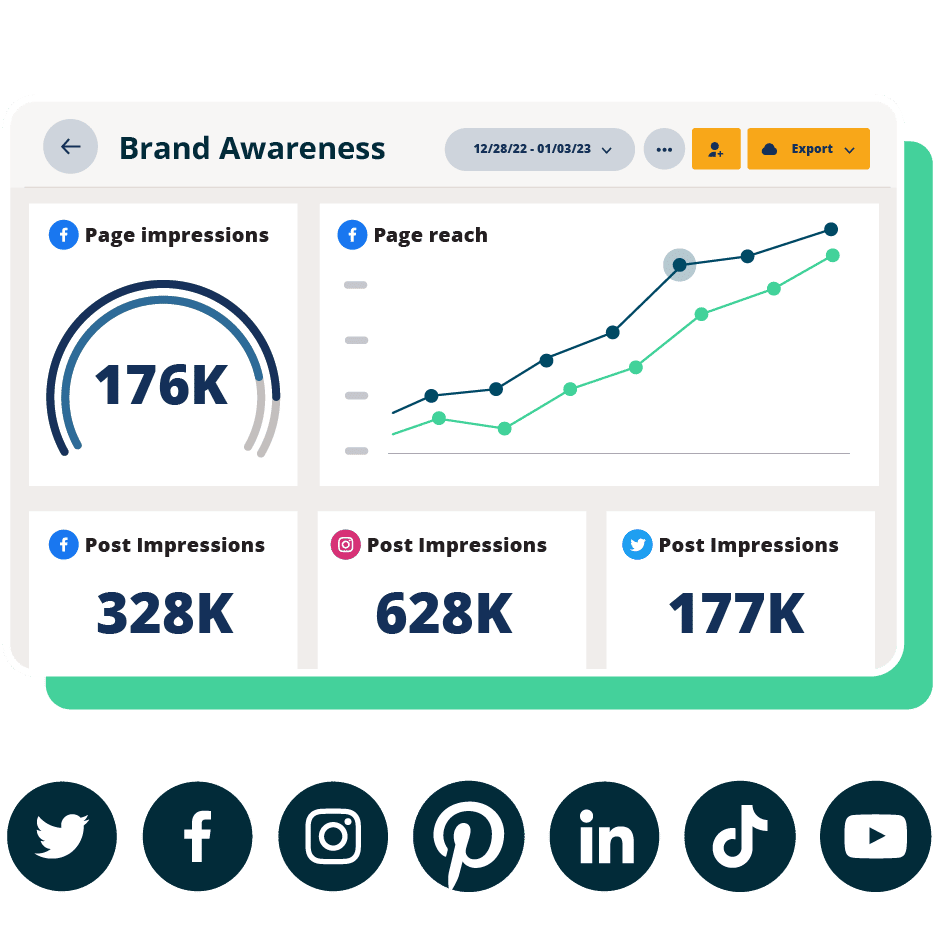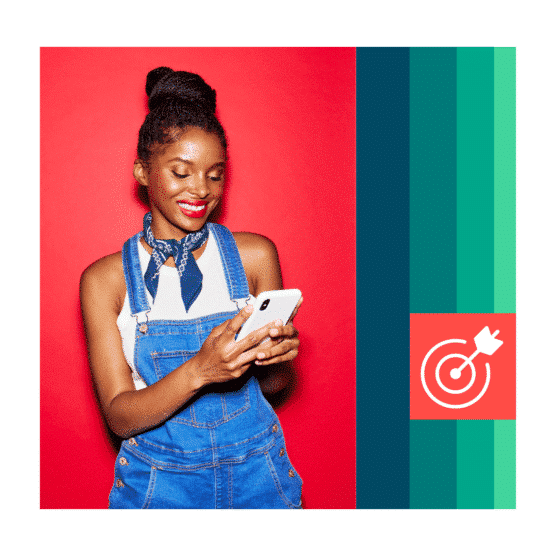Social media KPIs (or key performance indicators) are data-based measures of your progress toward important business goals. Understanding which KPIs matter and how to track them allows you to build and refine an effective social media strategy that supports organizational success.
KPI stands for key performance indicator.
Social media KPIs are the metrics used to guide your social media marketing strategy and determine whether that strategy is working.
Social media KPIs are a strategic take on key social media metrics, with clear targets to indicate the level of performance.
Social media changes fast, and there’s a lot of performance data available. Those factors combined mean it’s easy to get bogged down in the measurement details and lose sight of the bigger picture.
Tracking KPIs keeps you focused on real business goals. Rather than the numbers alone, you’re looking at how the numbers impact the direction your business is going. You understand how you’re progressing toward your goals, and whether you need to make strategic changes along the way.

Beautiful reports. Clear data. Actionable insights to help you grow faster.
Start free 30-day trialUnderstand your business objectives
Your social media KPIs should always be tied to an overall strategic goal. Ask yourself: what’s the end game?
For example, is the goal of your social campaigns to increase brand awareness? Drive website traffic? Or to get more conversions and sales?
Once you decide on a strategic direction, it’s time to break that down into individual goals and associated KPIs for social media. For example, if your end game is to drive website traffic, then one of your KPIs might be tied to the number of clicks from social media to your site. To maximize your effectiveness, consider strategies like zero-click content that can keep users engaged without leaving the platform.
But to set realistic KPI targets, you first need to do the following.
Track competitors and industry benchmarks
What does success look like for social accounts similar to yours?
With Hootsuite’s social media benchmarking, you can find out how others in your industry are doing on social and compare your results for social media metrics like:
- Profile impressions
- Profile reach
- Followers
- Audience growth rate
- Engagement rate
- Video plays
- Posting frequency
- Clicks
- Shares

You can also get even more granular and compare your performance to specific competitors rather than your industry as a whole.
If measuring KPIs on social media is new to your team, make sure you collect your own benchmark data too, so you know where you’re starting from.
Set SMART goals
Comparing your current performance to that of your overall industry gives you a good framework for setting realistic KPI targets. Like your overall business goals, your social media KPIs should be SMART:
- Specific: Include a clear target. For example, do you aim to increase the brand’s Instagram follower count by 500 in the next month? Do you want to increase your click-through rates by 20% by the end of the year?
- Measurable: KPIs incorporate metrics to track and quantify your progress. You should always be able to determine how close you are to meeting the goal.
- Attainable: Keep it real. Set KPIs that are within an achievable scope based on the overall industry and your own resources.
- Relevant: Make sure each social media KPI connects to the business’s larger goals.
- Timely: What’s the timeframe for achieving this goal and determining whether success has been met? One month, six months, one year?

Beautiful reports. Clear data. Actionable insights to help you grow faster.
Start free 30-day trialChoose the relevant metrics and structure your KPIs
Now that you know how your KPIs will support your business goals, decide on the specific metrics that will help you measure your progress.
For example, if your business is focused on growth and you want to build brand awareness on social media, you might want to measure and track Instagram Reels views.
For each KPI, craft a statement that incorporates all the SMART elements along with the relevant metrics. We’ll break down some examples later in this post.
Track and analyze your performance
KPIs include a set timeframe for success, but you can’t wait until that time has elapsed to check in on your progress. Choose a reporting pattern that will help you clearly see growth and developments, and react quickly when things aren’t working great.
This is where you’ll really dig into the metrics associated with your KPIs, and look for strategic ways to improve your results. Are things moving in the right direction? At the pace you’d planned?
You can also dig deeper here and analyze standout successes (or missteps) to see what lessons you can apply to your overall strategy as you work towards achieving your KPIs.
Review and recalibrate
Remember: No company’s business goals are set in stone—that means the social media KPIs you set will also need to evolve over time.
Schedule regular strategic reviews of your KPIs. Are they still relevant? Are they still helping you meet company goals? Should changes be made?
Remember: why and how you set KPIs for social media could change as the business changes. They could also change for external reasons, like algorithm updates or the emergence of new platforms.
We’ve broken the building blocks of social media KPIs down into five categories:
- Reach
- Engagement
- Conversion
- Social customer service
- Social commerce
Remember, your social media KPIs will incorporate SMART components like targets and timeframes. Think of the KPIs below as the foundation, and those SMART components as the building elements that make your KPIs unique to your business and your strategic goals.
Reach KPIs
Reach KPIs measure how many users come across your social media channels.
Think of reach as a quantity measurement—reach data demonstrates your existing and potential audience, growth over time, and brand awareness.
1. Impressions
This is the number of times your post was visible in someone’s feed or timeline. This doesn’t necessarily mean the person who viewed the post noticed it or watched it, but you know for sure it appeared on their screen.
2. Follower count
The number of followers your social channel has at a set time.
3. Audience growth rate
You want to make sure you’re gaining followers, not losing them. Audience growth rate demonstrates how your follower count is changing over time. To track this metric, divide your net new followers by your total follower count.
4. Reach
This is how many people see a post. Reach changes based on factors like when your audience is online and how good your content is. It gives you an idea of what your audience finds valuable and interesting.
Engagement KPIs
KPIs for social media engagement measure the quality of the interactions with your social followers. They show you whether your audience is connecting with what you have to say and is willing to interact with your brand.
5. Likes
The number of times followers interact with a social post by tapping the Like button within a given social media platform.

Source: @AirCanada
6. Comments
The number of times people comment on your posts. A comment requires more effort than a simple like and is generally considered to represent a higher level of engagement.
However, comments can have a positive or negative tone, so a high number of comments isn’t always a good thing! For this to be a meaningful engagement KPI, social media managers also need to track social sentiment.

Source: @botanygeek
7. Clicks
How many times users click the link in your post. This helps track how people are engaging with content beyond the social platform.
Using the Ow.ly URL shortener allows you to track clicks in Hootsuite Analytics, without setting up any additional tracking.

8. Shares
How many times your post has been shared from one user to another. This is a great measure of how engaging and viral your content is.

Source: @Versace
Shares are not necessarily a direct measurement of success, since the number of shares alone doesn’t tell you if people like or don’t like what they see. However, it provides a good indication of whether people are passionate enough to spread the word.
9. Saves
Saves (or bookmarks) generally indicate that people like your content and find it useful enough that they plan to return to it later. This is a good indication that you’ve provided something educational, entertaining, or otherwise valuable to your audience.

Source: @Hootsuite
10. Average engagement rate
This metric divides all the engagement a post receives — including likes, comments, saves and shares — by the total number of followers on your social account. It shows how engaging, on average, your content was.
If you don’t want to do the math yourself, try our free engagement rate calculator.
11. Amplification rate
This is a measure of how much your followers extend your reach by sharing your content with their own followers. A high amplification rate shows that your followers want to be associated with your brand or find your content valuable enough to pass along.
Here’s how to calculate it:

12. Social share of voice
This metric tracks how many people mentioned your brand, compared to the number of people mentioning your competitors. It shows how relevant your brand is within your industry.
You can use a social listening tool like Hootsuite to measure your own and your competitors’ mentions during a specific timeframe. To calculate social share of voice, divide your brand mentions by the total number of industry mentions.
Conversion KPIs
Conversion KPIs on social media reveal whether your social strategy is leading to real-world outcomes beyond the social sphere.
13. Click-through rate (CTR)
CTR is the percentage of people who viewed your post and clicked on the CTA (call to action) it included. This provides insight into whether your content captures your audience’s attention and inspires them to act.
Here’s how to calculate it:

14. Conversion rate
This is the number of users who perform the action in your social media CTA (visit your website or landing page, subscribe to a mailing list, make a purchase, etc.) compared to the total number of clicks on a given post.
A high conversion rate indicates your content is contributing to your sales funnel or otherwise supporting business growth.
Here’s how to calculate it:

15. Bounce rate
Not everyone who clicks on your social media links will follow through, reading the full article you shared or completing a purchase.
Bounce rate is the percentage of visitors who clicked on a link in your social post, but then quickly left that page without taking any action. You want this to be low—it signals the user experience you provided didn’t match expectations.
16. Cost per click (CPC)
CPC is the amount you pay for each individual click on your social media ad. Track this to see if the amount you’re spending is a worthwhile investment.
17. Cost per thousand impressions (CPM)
This is the amount you pay every time 1,000 people are served your social media ad. Since this is all about awareness rather than conversion, you want the cost to stay relatively low. Make sure you understand your sales funnel so you can tie the value of exposure to real business growth.
Social customer service KPIs
Customer service KPIs track how social media users feel about their experiences with your brand.
18. Customer satisfaction score (CSAT)
This metric shows how happy your customers are with their experience following an interaction with your social customer service team.
To get this data, you need to send users a survey after their customer service experience asking them to rate their level of satisfaction with the interaction. A tool like Hootsuite Inbox can send CSAT surveys automatically and pull the data into Hootsuite Analytics for reporting.
19. Net promoter score (NPS)
Your net promoter score measures your followers’ brand loyalty. After someone makes a purchase or has an interaction with your customer service team, ask them one question: How likely would you be to recommend this product to a friend?
Give respondents the chance to answer using a numerical scale, usually of 1 to 10.

20. Customer lifetime value (CLV)
Customer lifetime value refers to the total amount of money that a customer will spend on your product or service over their entire lifetime as a customer. Understanding your CLV gives you a sense of how much you can afford to invest on individual customer acquisition.
Here’s how to calculate CLV:
CLV = Average purchase value x Average purchase frequency x Average customer lifespan
21. Average response time
This is a measure of how long it takes for a customer service agent to respond to a customer after their first contact. You want to get this number down as low as possible. A social media chatbot can help by resolving many basic customer queries without agent intervention.
You can calculate your response time by dividing the total time spent on initial customer queries by the total number of queries addressed. Or, you can use a tool like Hootsuite Inbox to track response time automatically.
22. First contact resolution rate
This measures how often customers get a resolution from the first agent they speak to. If you’re using an automated assignment tool, this measures how well the tool understands customer requests and which team members can answer them.
Customers get increasingly frustrated each time they are passed along to another team member, especially if they have to keep explaining their problem, so a higher first contact rate will generally lead to higher customer satisfaction.
Again, tools like Hootsuite Inbox can track this for you automatically. Or, you can contact your first contact resolution rate manually by dividing the number of cases resolved by the first agent by the total number of resolved cases.
Social commerce KPIs
If you’re using social media to sell products directly, you also need to measure the impact of social as a sales channel.
23. Revenue
Revenue shows how much money you’ve made through your social channels.
You can find this number in Google Analytics or by looking at your shop analytics, depending on whether your network offers e-commerce transactions directly on the platform.
24. Average order value
This is a simple calculation of how much the average customer spends on a single purchase through your social commerce channels.
Like customer lifetime value, this helps you understand how much to spend on customer acquisition. However, this is a more short-term view of customer value that allows you to make on-the-fly decisions about budget allocation in social commerce campaigns.
25. Return on Investment (ROI)
Understanding your costs is important, but even more important is understanding the return you get on the money you pay for social ads and your social marketing strategy in general.
Each brand will define “value” differently. You might specifically mean income from sales tied to your social strategy, but you could also want to assign value to brand awareness or growing your social following.
You can also use a tool like Hootsuite Advanced Analytics to calculate ROI for you.

Social media KPI examples
As we mentioned up at the top, effective KPIs include clear targets based on the SMART methodology for setting realistic goals. This allows you to ensure that your KPIs are aligned with organizational needs and capabilities. Let’s look at a couple of KPI examples for social media.
KPI example 1:
Increase engagement rate on organic Instagram posts by 12% in Q3
Here’s you’ve got a clear metric (engagement rate), a specific platform (organic Instagram), a goal for the result (12% improvement), and a timeframe (Q3).
Since this KPI has a three-month timeframe (one quarter), you’ll likely want to check your progress biweekly or even weekly. You never want your KPI results to be a surprise—you need to check in regularly to see how you’re progressing and whether you need to adjust your strategy to get closer to achieving your goal.
KPI example 2:
Reduce average first response time by 10% year-over-year
Sometimes, rather than achieving a KPI within a set time, it makes sense to compare apples to apples by aiming for year-over-year changes. This allows you to account for regular ebbs and flows tied to busier periods like holidays and sales.
Since this is a year-over-year comparison, you’ll need a tool that allows you to pull data from the current period as well as the same period a year ago. You can then do a direct comparison. So, even though this is structured as an annual goal, you can check your progress by doing a y-o-y comparison at any time.
Now that you know what to measure, let’s look at how to track KPIs on social media.
Native solutions
Tracking KPI social media marketing progress natively—meaning, using the built-in analytics features of individual social media platforms—is one option. They’re free, easy to use, and can be a good option for social media managers who are only tracking KPIs for one or two social accounts.
Social media managers can track KPIs using Instagram Insights, Meta Business Suite, X (formerly Twitter) Analytics, etc. All major social media platforms offer basic solutions for tracking social media performance.
Keep in mind, however, that native solutions are limited to tracking metrics for one platform. This makes it difficult to compare and analyze data over multiple networks at once. You will also have to do a fair bit of math for more advanced KPIs.
If you go this route, you can make your reporting easier with our free social media KPI report template.
Tracking social media KPIs with Hootsuite
Hootsuite makes it much easier to collect, crunch, and share social media KPI data. Hootsuite Analytics tracks performance data for all of your social channels and organizes the KPIs into comprehensive reports that are easy to understand.
Hootsuite’s analytics reports are fully customizable to calculate and showcase the exact data you need. You can create reports for individual social accounts or for all the social platforms your brand uses. Think of it as your custom social media KPI dashboard.

With Advanced Analytics and Hootsuite Inbox you can track more complex KPIs relating to conversions, ROI, and service response results.

The interactive interface does not require any manual data input. It pulls the numbers in automatically, and you can simply drag and drop all of the elements to arrange a unique report based on your needs.
Here’s how to create a social media KPIs report in Hootsuite:
- In your Hootsuite dashboard, go to Analytics and click Create a report.
- Choose an existing report template, or select Custom report to build your own social media KPI report by selecting from the metrics library.
That’s it! You’ll get a custom graphical report with all the social media KPI data you need. You can also set the report to auto-update on a set schedule so it appears in your inbox in line with your KPI check-in cadence.
Use Hootsuite to do all your social media reporting from a single dashboard. Choose what to track, get compelling visuals, and easily share reports with stakeholders. Try it free today.







